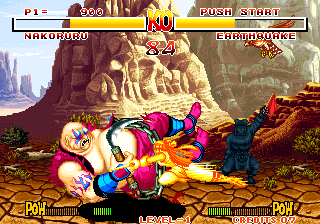Retro Replay Review
Gameplay
Samurai Shodown’s gameplay stands out in the crowded fighting game genre thanks to its deliberate pace and emphasis on weapon-based combat. Each duel feels strategic, rewarding players who master timing and spacing over button-mashing. The twelve base fighters, complemented by three hidden characters, offer a diverse roster of samurai, ninja, and mystical warriors, each boasting distinct weapons, fighting styles, and move sets designed to suit different playstyles.
(HEY YOU!! We hope you enjoy! We try not to run ads. So basically, this is a very expensive hobby running this site. Please consider joining us for updates, forums, and more. Network w/ us to make some cash or friends while retro gaming, and you can win some free retro games for posting. Okay, carry on 👍)
One of the most engaging features is the built-in mission structure for each character. Beyond simply defeating the final boss, players must accomplish specific goals—such as landing a fatal blow using a designated technique or surviving multiple rounds without taking damage—to unlock hidden endings and bonus content. This layer of challenge adds tremendous replay value, encouraging players to experiment with every warrior and perfect their strategies.
However, owners of the Genesis version should be aware of the notable omission of the Earthquake stage transition, a casualty of the console’s 16-bit memory constraints. While this doesn’t hinder the core mechanics, purists may miss this dramatic environmental effect. Thankfully, the rest of the roster’s special moves, counters, and rage mechanics remain intact, preserving the depth and intensity that fans expect from the series.
Overall, Samurai Shodown rewards patience and precision. Combos aren’t the central focus—instead, the game encourages mastering each character’s strengths and exploiting your opponent’s mistakes. Whether you’re a newcomer to the franchise or a veteran fighter, the nuanced tactics and varied mission objectives will keep you coming back for more.
Graphics
The visual presentation in Samurai Shodown is a standout among early 1990s fighters. Character sprites are large and richly detailed, capturing the unique attire, weapons, and animations of each warrior. From the intricate patterns on samurai armor to the flowing robes of mystical monks, every design choice reflects the game’s feudal Japan setting with care and craftsmanship.
Backgrounds are equally impressive, featuring lush bamboo forests, moonlit temple courtyards, and war-torn villages rendered in vibrant color palettes. The Genesis version’s hardware limitations resulted in a slightly reduced color depth compared to arcade and other home ports, but the developers compensated with clever shading and layered parallax scrolling to convey depth and atmosphere.
Special moves are accompanied by flashy effects—glowing sword slashes, swirling energy blasts, and rim-shaking screen shakes on powerful strikes. Even without the Earthquake stage effect, the impact of ultimate techniques is unmistakable, providing satisfying visual feedback when you successfully land a critical blow on your opponent.
Subtle animations such as billowing capes, drifting cherry blossoms, and flickering torches in the background further immerse players in the era’s ambiance. While the Genesis port isn’t the definitive visual experience, it remains a technically impressive achievement that brings feudal Japan to life in pixel form.
Story
Set against the turbulent backdrop of early feudal Japan, Samurai Shodown’s narrative revolves around the rise of a heretical cult led by Shiro Tokisada Amakusa. Unbeknownst to his followers, Amakusa is merely a vessel for the wicked spirit Ambrosia, whose ultimate goal is to blanket the world in eternal night. This mythic struggle between light and darkness imbues every battle with epic significance.
Players choose from a roster of warriors, each bound to their own motivations and personal quests. From the disgraced ronin seeking redemption to the noble princess fighting for her clan’s honor, every character’s path leads them toward the looming showdown with Amakusa. The branching storylines and mission-driven structure create a tapestry of interconnected tales that reward multiple playthroughs.
The compact arcade-style storytelling allows for quick scene-setting before every fight, delivering just enough exposition to give context without bogging down the action. Unlocking character-specific endings reveals deeper layers of betrayal, sacrifice, and supernatural intrigue, offering fans a richer appreciation of the lore behind each fighter.
Although the Genesis port omits certain cinematic flourishes found in other versions, the core narrative remains intact. For enthusiasts of historical fantasy and samurai drama, Samurai Shodown’s story provides a compelling reason to master every warrior and uncover the true nature of Ambrosia’s plot.
Overall Experience
Samurai Shodown on the Genesis emerges as a highly engaging fighting game that distinguishes itself through deliberate pace, weapon-based combat, and character-driven missions. The learning curve may feel steep to those accustomed to faster, combo-centric fighters, but the payoff comes in mastering techniques, outsmarting opponents, and experiencing the thrill of well-timed counters and decisive strikes.
While the Genesis port does sacrifice the Earthquake effect and display some color limitations, its faithful translation of character animations, special moves, and atmospheric stages makes it a worthy addition to any retro collection. The hidden characters and multiple endings provide ample incentives for replay, ensuring that players return again and again to uncover every secret.
Whether you appreciate deep strategic duels, rich historical-fantasy storytelling, or simply the visceral satisfaction of a perfectly executed sword slash, this version of Samurai Shodown delivers on nearly all fronts. Its standout graphics, memorable soundtrack, and mission-driven structure elevate it above many contemporaries, making it not just a nostalgic classic but an enduring gem in the fighting genre.
In conclusion, Samurai Shodown for the Genesis offers a robust, immersive experience that will challenge both newcomers and veterans alike. If you value smart, weapon-oriented combat and an engaging feudal Japan narrative, this game is well worth adding to your library—even with a few technical concessions inherent to the hardware.
 Retro Replay Retro Replay gaming reviews, news, emulation, geek stuff and more!
Retro Replay Retro Replay gaming reviews, news, emulation, geek stuff and more!









Reviews
There are no reviews yet.